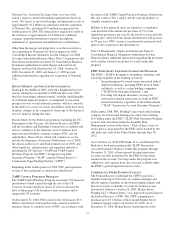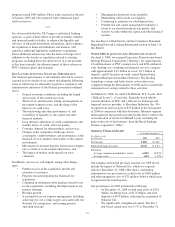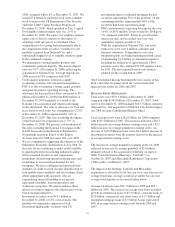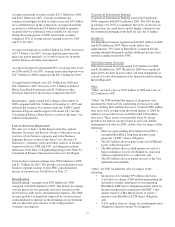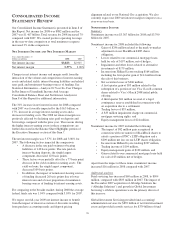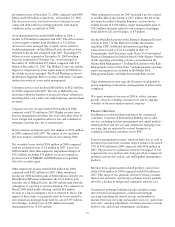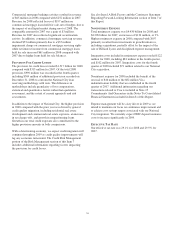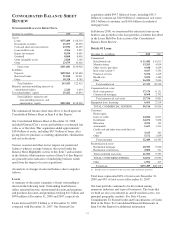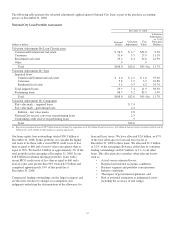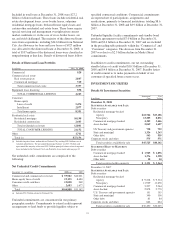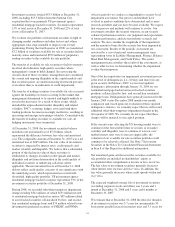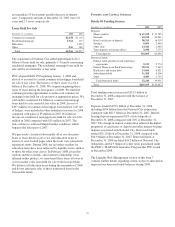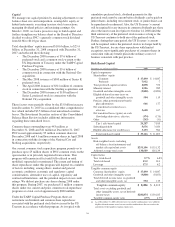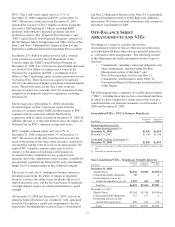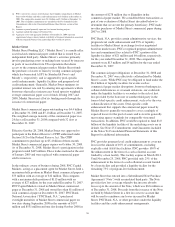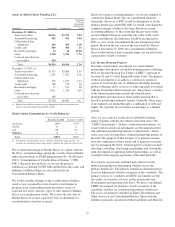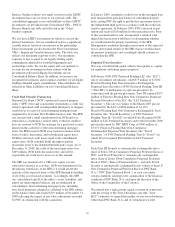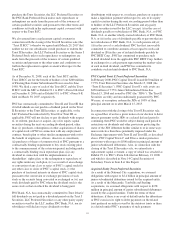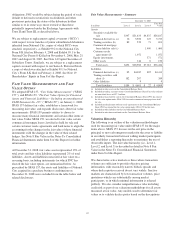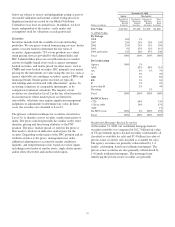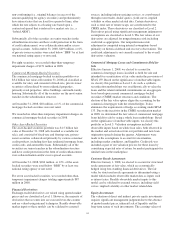PNC Bank 2008 Annual Report Download - page 38
Download and view the complete annual report
Please find page 38 of the 2008 PNC Bank annual report below. You can navigate through the pages in the report by either clicking on the pages listed below, or by using the keyword search tool below to find specific information within the annual report.Investment securities totaled $43.5 billion at December 31,
2008, including $13.3 billion from the National City
acquisition that were primarily US government agency
residential mortgage-backed securities. Securities represented
15% of total assets at December 31, 2008 and 22% of total
assets at December 31, 2007.
We evaluate our portfolio of investment securities in light of
changing market conditions and other factors and, where
appropriate, take steps intended to improve our overall
positioning. During the fourth quarter of 2008, we transferred
$3.2 billion of securities available for sale to securities held to
maturity status and transferred $599 million of proprietary
trading securities to the available for sale portfolio.
The transfer of available for sale securities to held to maturity
involved short-duration, high quality securities where
management’s intent to hold changed. In reassessing the
classification of these securities, management also considered
the current and ongoing illiquidity in the capital markets and
that securities prices are under increasing downward pressure,
even where there is no indication of credit impairment.
The transfer of trading securities to available for sale occurred
against the backdrop of events occurring in the market that
management determined to be unusual and highly unlikely to
recur in the near term. As a result of these events, which
included the unprecedented market illiquidity and related
volatility, PNC’s economic hedges associated with these
trading positions become increasingly ineffective, resulting in
increasing and unexpected earnings volatility. Coincident with
the transfer of trading securities to available for sale, all
hedging instruments were terminated.
At December 31, 2008, the investment securities balance
included a net unrealized loss of $5.4 billion, which
represented the difference between fair value and amortized
cost. The comparable amount at December 31, 2007 was a net
unrealized loss of $265 million. The fair value of investment
securities is impacted by interest rates, credit spreads, and
market volatility and illiquidity. We believe that a substantial
portion of the decline in value of these securities is
attributable to changes in market credit spreads and market
illiquidity and not from deterioration in the credit quality of
individual securities or underlying collateral, where
applicable. The net unrealized losses at December 31, 2008
did not reflect credit quality concerns of any significance with
the underlying assets, which represented an overall well-
diversified, high quality portfolio. US government agency
residential mortgage-backed securities represented 53% of the
investment securities portfolio at December 31, 2008.
During 2008, we recorded other-than-temporary impairment
charges totaling $312 million, of which $151 million related
to residential mortgage-backed securities, $87 million related
to asset-backed securities collateralized by first- and second-
lien residential mortgage loans and $74 million related to our
investment in preferred securities of FHLMC and FNMA.
At least quarterly we conduct a comprehensive security-level
impairment assessment. Our process and methods have
evolved as market conditions have deteriorated and as more
research and other analyses have become available. We expect
that our process and methods will continue to evolve. Our
assessment considers the security structure, recent security
collateral performance metrics, our judgment and expectations
of future performance, and relevant industry research and
analysis. We also consider the magnitude of the impairment
and the amount of time that the security has been impaired in
our assessment. Results of the periodic assessment are
reviewed by a cross-functional senior management team
representing Asset & Liability Management, Finance, Balance
Sheet Risk Management, and Credit Policy. The senior
management team considers the results of the assessments, as
well as other factors, in determining whether the impairment
is other-than-temporary.
One of the key inputs into our impairment assessment process
is the level of delinquencies (i.e., 60 days and more) for any
given security. In February 2009, we received updated
delinquency information through January 31, 2009 for our
residential mortgage-backed and asset-backed securities
positions collateralized by first- and second-lien residential
mortgage loans. Delinquencies have generally increased in the
January 2009 versus December 2008 month-over-month
comparison and, based upon our evaluation of these updated
delinquency statistics, we currently expect that we will record
additional other-than-temporary impairment charges in the
first quarter of 2009. We currently do not expect that these
charges will be material to our capital position.
If the current issues affecting the US housing market were to
continue for the foreseeable future or worsen, or if market
volatility and illiquidity were to continue or worsen, or if
market interest rates were to increase appreciably, the
valuation of our available for sale securities portfolio could
continue to be adversely affected. See Note 7 Investment
Securities in the Notes To Consolidated Financial Statements
in Item 8 of this Report for additional information.
Net unrealized gains and losses in the securities available for
sale portfolio are included in shareholders’ equity as
accumulated other comprehensive income or loss, net of tax.
The fair value of investment securities generally decreases
when interest rates increase and vice versa. In addition, the
fair value generally decreases when credit spreads widen and
vice versa.
The expected weighted-average life of investment securities
(excluding corporate stocks and other) was 3 years and 1
month at December 31, 2008 and 3 years and 6 months at
December 31, 2007.
We estimate that at December 31, 2008 the effective duration
of investment securities was 3.7 years for an immediate 50
basis points parallel increase in interest rates and 3.1 years for
34


